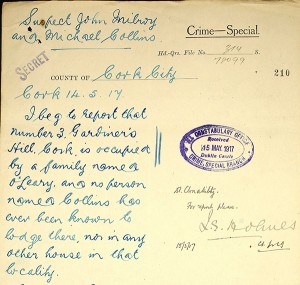‘Shooting is too good for ye hoors’
Published in Issue 3 (May/June 2016), News, Volume 24A REPORT ON THE LATEST DIGITAL RESOURCE FROM ANCESTRY.IE
By Joe Cully

Great progress has been made in the last few years in the digitisation of historical material and making it available on-line for professional and amateur historians alike. Indeed, it could be said that the digitisation revolution has significantly blurred the line between the professional and the amateur.
One of the newest on-line sources of interest to Irish historians is a collection of the intelligence files compiled by the British authorities on the growing nationalist movement between 1914 and 1922. The material, long held at the UK National Archives in Kew and which required a trip to London to view, can now be accessed—for free—at the genealogy website ancestry.ie. There is a small catch, however. While access to the files at ancestry.ie is free, to view the documents and images you must first open a (free) account with the site.
The material is superbly presented in a user-friendly pdf viewer. The documents are in sharp focus and easily manipulated. You can also save files either to your ancestry.ie account or straight to your computer, although, initially, accessing the information is not as straightforward as you might expect. The first thing to note is that the website, ancestry.ie, does not really exist; type that address into your browser and you are immediately directed to the .co.uk address, itself a trading post for the ancestry.com mothership. Even then, on this home page, there is no obvious link to the recently released documents pertaining to Ireland. Instead, scroll halfway down the page and click on the small link for ‘See all new records’. There we find, under ‘New and updated’, the ‘Ireland, Intelligence Profiles, 1914–1922’ and ‘Ireland, Courts Martial Files, 1916–1922’.
Included in the first collection are ‘photographs, newspaper clippings and notes recording Sinn Féin meetings as well as the everyday movements of those deemed to be suspects in the eyes of the British forces’. The records date mainly from 1917, but include some people who were involved in the nationalist movement earlier. The second collection covers field general courts-martial records, ‘with nearly 2,000 searchable names and additional names found within the images. Each record contains evidence against the defendants, their statements and proclamations.’
Much of the initial press coverage about ancestery.ie’s collection focused on the documents relating to the courts martial of the 1916 leaders. But the files are much more extensive. As the site says, ‘the records relate to individuals suspected of being involved with the Nationalist movement in Ireland. Arrests were made under martial law for conspiracy, murder, treason, and securing and publishing secret government information.’
As with traditional research, much of the thrill derives from coming across the unexpected and colourful. For instance, on a whim I searched for Cathal Brugha. Interestingly, rather than say ‘not found’, it offers up ‘Charles Burgess’. His is Castle File No. 180—and just above his typed name on the file folder is drawn, in red ink, in an almost childish hand, ‘D E A D’. (Imagine what the guy with the red biro was thinking!) The file consists largely of newspaper clippings, including the superb, colourful reports from the Evening Mail of 6 July 1922 of Brugha’s fatal charge from the flames of the Granville Hotel.
On another whim, I searched for ‘1919’ and was drawn to a file on the three Barlow boys from Shrough, Co. Tipperary. The RIC had raided the Barlow farm, where they discovered a large cache of arms and explosives. Arthur (26), Matthew (22) and John (20) Barlow were well-known activists. Indeed, Arthur was the local IRA commandant. He and Matthew were sentenced to two years with hard labour, while John got six months. And then there is the court martial of ‘Timothy Dwyer, of Cappamurra, Co. Tipperary, civilian, tried by District Court Martial at Cork on 13th March 1919, for having in his possession a number of documents, the publication of which would be likely to cause disaffection, in contravention of the Defence of the Realm regulations’. RIC Sergeant Patrick Headon of Dundrum gave evidence that Dwyer, a 24-year-old farmer, was ‘One of the leading Sinn Féiners of the district’. He was ‘commandant of the local Irish Volunteers, one of a party who assaulted and robbed Pte. Wainwright of his rifle’ a few months earlier.
Sergeant Headon told the court that he and his colleagues had searched the Dwyer farm and found, hidden in the oats bin in the stable, letters implicating Dwyer as ‘Commandant’ and minutes of a meeting of a ‘Brigade Council’. One of Sergeant Headon’s colleagues recounted: ‘When the accused was being taken away, a small crowd had collected. I heard the accused address them as follows: “He asked me was I commandant. I am glad to say I am a commandant, but not a commandant in the British army but a commandant in the Irish Republican Army”. The accused resisted arrest, refused to walk and was forced to do so. He had to be carried off by force. On the way down to the road he said, addressing us, “Shooting is too good for ye hoors”.’ Dwyer was found guilty and sentenced to fifteen months’ imprisonment with hard labour.
Joe Culley is a journalist and copy-editor.
















